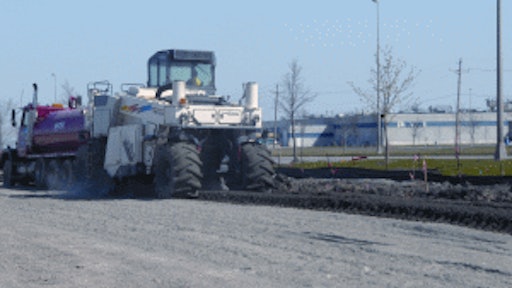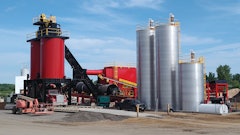
It's easy to overlook the fact that road preservation specialists are very active in helping building contractors develop successful project sites. But that type of work is an integral part of Tom Johnson's Midstate Reclamation's business. Based in Lakeville, MN, Midstate performs full-depth reclamation, cold in-place recycling, hot in-place recycling, and cold planing.
On a recent Fargo, ND commercial construction project, Midstate was called in to stabilize soft soil conditions common to the Fargo area. As a road reclamation expert, Midstate's knowledge of how to best stabilize a variety of soil conditions provides site developers with the most cost-effective solution in improving the stability of the underlying subgrade before placing an asphalt overlay.
"This was a private full-depth reclamation project for a new building that had a tight deadline for completion," notes Johnson, president and owner of Midstate. "We had another wet spring with flooding in the Fargo area, so we were fortunate to have a few days of dry weather to get in and complete the work required on the six-acre parcel."
The owner of the new Catco truck service center wanted to stick with a June 11 opening and that required a solid parking lot structure surrounding the building. With a business that services heavy trucks, Midstate decided a cement additive would be the best solution in firming up the soft soil conditions evident throughout the project site.
"When the soil gets wet it takes on a real silty consistency. Fortunately, we had several days of dry conditions that allowed us to get in and get our work done," Johnson says. "We worked with a soil engineer who conducted several tests to determine an appropriate mix design that required a 7% cement additive."
That design translated into 75 pounds of cement per square yard of soil being treated 12 inches deep.
"Our reclaimer is set up to mix cement (spread out over the surface based on mix design requirements), soil and the right amount of water based on computer readouts of existing soil conditions," Johnson says. "Not all building sites are going to have ideal soil conditions and most of the good sites have already been taken, but we believe we can provide the right treatments to achieve a solid and stable product."
About the best way Johnson can describe the soil conditions in the Fargo area is by comparing them with what he is used to in the Minneapolis area.
"Minneapolis soil supports approximately 3,000 pounds per square inch and Fargo approximately 2,000 pounds per square inch. That means a building in Minneapolis requiring a two-foot-wide footing would require a three-foot-wide footing in Fargo," Johnson says. "There's just more movement in the clays of the Fargo area. The cement additive firms up that soft clay, fills the air voids, and within 48 to 72 hours the cement cures, and the structure is solid."
Typically Midstate performs more fly ash stabilization than cement stabilization, but in this particular application, treating 15,000 square yards of soil with 530 tons of cement proved to be the best, most cost-effective solution in building a stable base structure for the property owner.
All preliminary grading work was performed by another subcontractor to remove topsoil and achieve the correct slope and grade before Jonson's crew was brought in to treat what would be the subgrade for the final surface application.
Midstate used a Wirtgen 2500 reclaimer to blend cement and soil, and inject water in the full-depth 12-inch stabilization process. A pad-foot compactor was used to achieve density, followed by a Caterpillar 140G motor grader to achieve final grade and a single steel-drum roller to smooth the surface.
General contractor's perspective
Earl Gebauer, vice president of Shaw Construction, the general contractor on the Catco project, says the decision to stabilize the soil in the parking area was based primarily on making sure the parking lot area of the project would be completed by the June opening deadline and to extend the service life of a lot that would experience heavy loads from over-the-road trucks requiring service.
Gebauer, who was in charge overseeing the design and construction of the project, says the softer clay soil conditions are common to projects he's been involved with in the Fargo area. Fortunate for Shaw and other contractors working on the project, Fargo had a relatively warm and dry spring even with some of flooding that occurred earlier.
"Normally we can expect to get about 10 to 15 years of service life out of a parking lot built on normal soil conditions," Gebauer says. "But this project required some stabilization to prevent shifting and rapid deterioration caused by the frost/thaw cycle we experience in this part of the country."
By going with a soil stabilization process, the owner was also able to reduce the amount of aggregate subbase required to be placed over the treated soil before a final surface covering was placed.
"One-third of the parking lot (used for office parking) was designed with a five inch asphalt surface, while the other two-thirds (used for truck access and parking to the service area of the business) was designed to be covered with recycled crushed concrete and recycled asphalt pavement on the surface for dust control," Gebauer says. "We worked with an engineering firm to come up with the optimal mix design (percentage of cement additive that would provide the optimal structural integrity of the soil once the blended mixer was compacted and cured), and we were able to remove four inches of aggregate base out of the section that was covered with bituminous asphalt and three inches out of the section that was covered with crushed recycled concrete and recycled asphalt."
"After taking samples from the site, we conducted tests to determine the optimum moisture content that would allow us to achieve maximum density," notes Mark Kalahar, operations supervisor for Braun Intertec, the geotechnical engineering firm hired to analyze and design a mix-design solution to stabilize the project's soft soil conditions. "The site is in an area that once was an ancient lake bed, so we know it's susceptible to frost and the 'fat clays' tend to shift around more than other clay materials. The cement additive controls the moisture content (stabilizes the material to the point where it maintains a consistent moisture level) and that's what enables the contractor to achieve an optimal density."
"We know that treating the 15,000 square yards of soil with cement added between $70,000 and $80,000 to the cost of the project, but we also know we saved money by reducing the aggregate you would normally bring in to construct the base," Gebauer says. "We also are pretty confident the stabilization process will add years of service to the parking lot structure."


























